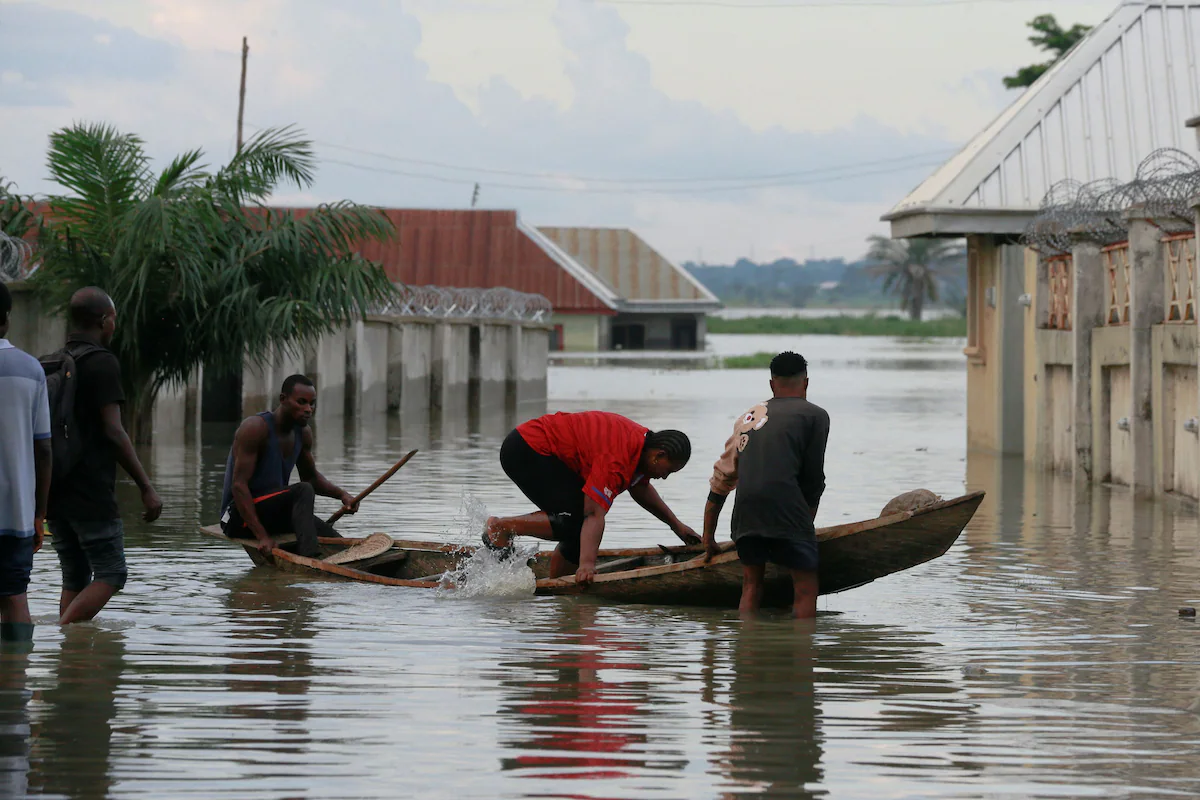World falls ‘pitifully short’ of meeting climate goals, U.N. report says
from WaPo — See also NYTimes Climate Pledges Are Falling Short, and a Chaotic Future Looks More Like Reality (“With an annual summit next month, the United Nations assessed progress on countries’ past emissions commitments. Severe disruption would be hard to avoid on the current trajectory.”)
By Sarah Kaplan|Oct. 27th, 2022
Despite a high-profile promise to boost ambitions at last year’s U.N. climate summit, nations have shaved just 1 percent off their projected greenhouse gas emissions for 2030, a new United Nations report found — leaving Earth on track to blow past a safe temperature threshold by almost a full degree.
Thursday’s report on the emissions gap — the gulf between national plans to reduce carbon pollution and the actual cuts needed to avert catastrophic warming — found that countries’ strongest climate pledges put the Earth on a path to warm by a dangerous 2.4 degrees Celsius (4.3 degrees Fahrenheit) by the end of the century. And few nations have implemented the policies needed to meet even these lackluster targets, the report said.
“Global and national climate commitments are falling pitifully short,” U.N. Secretary General António Guterres said in a video message. “We must close the emissions gap before climate catastrophe closes in on us all.”
In the face of the war in Ukraine, the ongoing coronavirus pandemic and widespread economic upheaval, the emissions gap report shows, nations have made little progress toward meeting the Glasgow climate summit goal of limiting warming to 1.5 degrees Celsius (2.7 degrees Fahrenheit) above preindustrial levels.
“The world has got to learn that crises will continue, and we can’t afford to lose our attention,” said Inger Andersen, executive director of the U.N. environment program, which oversees the report.
Unless people take dramatic action to transform economies and eliminate fossil fuels, Andersen warned, humanity faces a hellish future that will make today’s climate disasters seem mild by comparison.
The new emissions gap analysis — the 13th study of its kind from the United Nations — comes on a wave of new findings about the world’s climate failures. On Wednesday, the United Nations Framework Convention on Climate Change (UNFCCC) reported that only a small minority of countries had revised their climate pledges since the end of the Glasgow conference, leaving the world “nowhere near” the emissions cuts needed to avoid climate catastrophe.
Another study released Wednesday by the World Meteorological Organization found that methane emissions are rising faster than ever before, raising questions about humanity’s ability to limit the greenhouse gas that is 80 times more potent than carbon dioxide in the near term.
In its annual “Countdown” report on the health effects of climate change, the prominent medical journal the Lancet warned that “overreliance on fossil fuels could lock in a fatally warmer future.” Even as rising temperatures put billions of people at risk from unbearable heat, violent disasters and surging infectious disease, the report said that many governments spend more of their national budgets on fossil fuel subsidies than on public health measures.
Meanwhile, a new report by seven climate nonprofits looked at 40 indicators of climate progress and showed that not a single one is on track for the world to meet its 2030 targets. Public financial support for clean energy and other climate projects is one-tenth of what it needs to be, the “State of Climate Action” report found. Efforts to phase out coal need to happen six times faster. Fossil gas is on track to become an even greater source of electricity by the end of the decade, even as scientists say its role has to shrink.
Yet the emissions gap report shows it’s still physically possible — if politically challenging — for people to achieve the 1.5 degrees Celsius goal, Andersen said.
There are some glimmerings of progress. In its authoritative World Energy Outlook released Thursday, the International Energy Agency said investments in clean energy this year hit $1.3 trillion — edging out fossil fuels, which received about $1 trillion.
“Even with current policies, by 2030 clean energy investments will reach $2 trillion,” said IEA executive director Fatih Birol. “This is real money being put on the table, rather than strategies.”
But the emissions gap report underscores how much more is needed. It will take investments of $4 trillion to $6 trillion per year in renewable energy, clean transportation, efficient buildings and sustainable agriculture, the report said, for the world to avert catastrophic warming and achieve a decent standard of living for billions of people around the globe.
“Now is the time to step up,” Andersen said, referring to political leaders. “It is in our distinct interest to handle this now” — before it becomes impossible to handle.
 The emissions gap report represents the most comprehensive annual assessment of the world’s warming trajectory, summarizing estimates from the United Nations as well as independent sources to analyze how much temperatures will increase under four distinct emissions scenarios.
The emissions gap report represents the most comprehensive annual assessment of the world’s warming trajectory, summarizing estimates from the United Nations as well as independent sources to analyze how much temperatures will increase under four distinct emissions scenarios.
Global greenhouse gas pollution is still on the rise, the report found. Pending a final assessment of how much carbon was released and absorbed by natural ecosystems, it seems likely that 2021 set a record high for carbon emissions — reversing a temporary decline linked to economic shutdowns during the coronavirus pandemic in 2020.
To avoid exceeding the 1.5 degrees Celsius target, humanity can afford to release roughly 360 billion metric tons of carbon dioxide equivalent into the atmosphere between now and the end of time (or, at least, the end of our climate models). But if current policies don’t change, scientists said, the world will blow through that budget in about a decade.
At today’s rate of emissions, global average temperatures have a better-than-even chance of rising 2.8 degrees Celsius (5 degrees Fahrenheit) by the end of the century, the report found.
This represents only a slight improvement over last year’s outlook, largely due to the Inflation Reduction Act passed by Congress this summer. The $370 billion investment in renewable energy and other climate-friendly technologies is expected to reduce U.S. greenhouse gas emissions by about 1 billion metric tons of carbon dioxide equivalent by the end of the decade.
Yet that reduction still falls short of the U.S. promise to limit its 2030 carbon output to about half of 2005 levels — a cut of more than 2 billion metric tons. And it is an order of magnitude smaller than the global 45 percent reduction from current levels required to stave off the worst effects of climate change, said Joeri Rogelj, a lead author of the report.
“We are falling terribly short of what we should be doing,” added Rogelj, a climate scientist at Imperial College London.
Next, the scientists looked at countries’ carbon-cutting pledges under the Paris climate agreement, known in United Nations jargon as “Nationally Determined Contributions,” or NDCs.
The outcome of the Glasgow conference included a promise that all nations would revisit their NDCs and adopt stronger commitments by the end of this year. But according to the UNFCCC, only 24 countries have submitted new pledges as the end-of-year deadline approaches — and most of these aren’t meaningfully different from countries’ previous plans.
If nations follow through with their “unconditional” NDCs — the pledges that don’t rely on financial assistance or other forms of support from the global community — they should be able to curb their 2030 emissions by about 5 percent, reducing projected warming to 2.6 degrees Celsius (4.7 degrees Fahrenheit)
And if developing countries do get the help they need to fulfill their “conditional” NDCs, emissions in 2030 will be 10 percent lower than if they stick with their current policies, allowing the world to limit warming to about 2.4 degrees Celsius, the report found.
These estimates are slightly different from the projected 2.5 degrees Celsius (4.5 degrees Fahrenheit) of warming laid out in Wednesday’s UNFCCC report — a discrepancy that Rogelj said could be explained by the fact that the emissions gap report summarizes multiple independent warming estimates while the UNFCCC study represents just one.
But both estimates fall within the acceptable range of uncertainty, Rogelj said. And neither prospective future would be tolerable for vast swaths of humanity. Already, this year’s record-setting drought in the United States, floods in Pakistan and famine in East Africa have shown the dangers of a world that is no more than 1.2 degrees Celsius (2.2 degrees Fahrenheit) warmer than during the preindustrial era, he pointed out.
The emissions gap report also examined the longer-term promises made by some countries to zero out carbon emissions by the middle of the century. If nations make good on these commitments, future warming levels could be as low as 1.8 degrees Celsius (3.2 degrees Fahrenheit), it found.
But unlike the NDCs, these “net zero” promises are not binding international agreements. And the gulf in ambition between nations’ modest near-term targets and their long-term aspirations raises the question of whether these far-off commitments are truly credible, Andersen said.
Shifting from these dangerous trajectories to a path toward just 1.5 degrees Celsius of warming will require nothing less than “economywide, society-wide” transformation, Rogelj said. To have a hope of getting on a safer path, the world must avoid building new fossil-fuel infrastructure that locks in continued pollution, rapidly expand renewable sources of electricity, promote energy-efficient buildings and invest in cleaner forms of transportation.
“We cannot do it just by setting low targets and tinkering here and there,” he said. “We really need to reimagine our societies.”
Steven Mufson contributed to this report.

